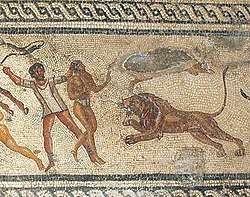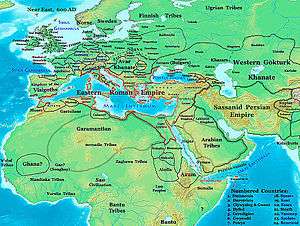Garamantes
The Garamantes (Berber: aɣrem, "castle") were an ancient civilisation based primarily in present day Libya.[1] They most likely descended from Iron Age Berber tribes from the Sahara, although the earliest known record of their existence dates to the fifth century BC.[1] Little remains of their civilization, as their epigraphy is nearly indecipherable;[2] much of what is known comes from contemporaneous Greek and Roman foreign accounts and modern archaeological findings.

The Garamantes emerged as a major regional power in the mid second century AD, establishing a kingdom that spanned roughly 70,000 square miles in the Fezzan region of southern Libya. Their growth and expansion rested on a complex and extensive qanat irrigation system (known as foggaras in Berber), which supported a strong agricultural economy and large population. They subsequently developed the first urban society in a major desert that was not centered on a river system; their largest town, Garama, had a population of around four thousand, with an additional six thousand living in surrounding suburban areas.[1]
At its height, the Garamantian kingdom enjoyed a "standard of living far superior to that of any other ancient Saharan society."[1] The Garamantes annexed and dominated surrounding tribes and relied heavily on enslaved peoples for their prosperity. The state began to decline in the fifth century as their source of water diminished, causing their kingdom to fragment and ultimately become annexed by surrounding powers.
Until the mid 20th century, the Garamantes were believed to be a small and minor desert tribe. Beginning in the 1960s, archaeological excavations have revealed the Garamantes to be "brilliant farmers, resourceful engineers, and enterprising merchants who produced a remarkable civilization."[1]
History

The Garamantes were probably present as a tribe in the Fezzan by 1000 BC. They appear in the written record for the first time in the 5th century BC: according to Herodotus, they were "a very great nation" who herded cattle, farmed dates, and hunted the Ethiopian cave-dwellers who lived in the desert, from four-horse chariots.[3] Roman depictions describe them as bearing ritual scars and tattoos. Tacitus wrote that they assisted the rebel Tacfarinas and raided Roman coastal settlements. According to Pliny the Elder, Romans eventually grew tired of Garamantian raiding and Lucius Cornelius Balbus captured 15 of their settlements in 19 BC. In 202, Septimius Severus captured the capital city of Garama.[4]

By around 150 AD the Garamantian kingdom (in today's central Libya (Fezzan), principally along the still existing Wadi al-Ajal), covered 180,000 square kilometres in modern-day southern Libya. It lasted from about 400 BC to 600 AD.
The decline of the Garamantian culture may have been connected to worsening climatic conditions, or overuse of water resources.[5] What is desert today was once fairly good agricultural land and was enhanced through the Garamantian irrigation system 1,500 years ago. As fossil water is a non-renewable resource, over the six centuries of the Garamantian kingdom, the ground water level fell.[6] The kingdom declined and fragmented.
The last news about Garamantes dates back to the VI-VII century. From Byzantine sources it is known that in 569 their king, probably a client king of the Byzantines, accepted Christianity. Muslim documents later state that in 668 the king of the Garamants was imprisoned and dragged away in chains. Eventually the whole region was absorbed into the area of Islamic influence.
Society
In the 1960s, archaeologists excavated part of the Garamantes' capital at modern Germa (situated around 150 km west of modern-day Sabha) and named it Garama (an earlier capital, Zinchecra, was located not far from the later Garama). Current research indicates that the Garamantes had about eight major towns, three of which have been examined as of 2004. In addition they had a large number of other settlements. Garama had a population of around four thousand and another six thousand living in villages within a 5 km radius.
The Garamantes were farmers and merchants. Their diet consisted of grapes, figs, barley, and wheat. They traded wheat, salt and slaves in exchange for imported wine and olive oil, oil lamps and Roman tableware. According to Strabo and Pliny, the Garamantes quarried amazonite in the Tibesti Mountains. In 2011, Nikita et al. reported that Garamantes skeletons do not suggest regular warfare or strenuous activities. "The Garamantes exhibited low sexual dimorphism in the upper limbs, which is consistent to the pattern found in agricultural populations and implies that the engagement of males in warfare and construction works was not particularly intense. [...] the Garamantes did not appear systematically more robust than other North African populations occupying less harsh environments, indicating that life in the Sahara did not require particularly strenuous daily activities."[7]
Archaeological remains
Archaeological ruins associated with the Garamantian kingdom include numerous tombs, forts, and cemeteries. The Garamantes constructed a network of tunnels, and shafts to mine the fossil water from under the limestone layer under the desert sand. The dating of these foggara is disputed, they appear between 200 BC to 200 AD but continued to be in use until at least the 7th century and perhaps later.[8] The network of tunnels is known to Berbers as Foggaras. The network allowed agriculture to flourish, and used a system of slave labor to keep it maintained . Marta Mirazón Lahr conducted research on skeletons from Fezzan dating to the Roman era and found that the skeletons most closely matched Neolithic sub-saharan African samples, from Chad, Mali, and Niger. Lahr associates these remains with the Garamantes, and concludes that the Garamantes had connections with both sub-saharan and northern Africa. [9]
References
- "Kingdom of the Sands - Archaeology Magazine Archive". archive.archaeology.org. Retrieved 2020-06-22.
- Werner, Louis. "Libya's Forgotten Desert Kingdom". saudiaramcoworld.com. Saudi Aramco World. Retrieved August 15, 2016.
May/June 2004; Volume 55, Number 3
-

- Birley (1999), p. 153.
- Beaumont, Peter (November 5, 2011). "Fall of Gaddafi opens a new era for the Sahara's lost civilisation". The Guardian. Retrieved June 21, 2019.
- Fentress and Wilson (2016)
- Nikita, Efthymia (2011). "Activity patterns in the Sahara Desert: An interpretation based on cross-sectional geometric properties". American Journal of Physical Anthropology. 146: 423–434. doi:10.1002/ajpa.21597.
- David Mattingly (ed.). 2003. Archaeology of Fazzan. Volume 1, Synthesis. London
- Marta Mirazón Lahr et al. (2010) "Human Skeletal Remains, Fazzan, Libya", The Society for Libyan Studies
Bibliography
- Birley, Anthony R. (1999) [1971]. Septimius Severus: The African Emperor. London: Routledge. ISBN 0-415-16591-1.
- N. Barley (Review). Reviewed work(s): Les chars rupestres sahariens: des syrtes au Niger, par le pays des Garamantes et des Atlantes by Henri Lhote Bulletin of the School of Oriental and African Studies, University of London, Vol. 48, No. 1 (1985), pp. 210–210
- E.Fentress and A. Wilson: 'The Saharan Berber diaspora and the southern frontiers of Vandal and Byzantine North Africa', in J. Conant and S. Stevens (eds),North Africa under Byzantium and Early Islam, ca. 500 – ca. 800 (Dumbarton Oaks Byzantine Symposia and Colloquia. Washington, D.C.: Dumbarton Oaks Research Library and Collection). 41-63.
Further reading
- Timothy F. Garrard. Myth and Metrology: The Early Trans-Saharan Gold Trade The Journal of African History, Vol. 23, No. 4 (1982), pp. 443–461
- Ulrich Haarmann. The Dead Ostrich Life and Trade in Ghadames (Libya) in the Nineteenth Century. Die Welt des Islams, New Series, Vol. 38, Issue 1 (March 1998), pp. 9–94
- R. C. C. Law . The Garamantes and Trans-Saharan Enterprise in Classical Times The Journal of African History, Vol. 8, No. 2 (1967), pp. 181–200
- Daniel F. McCall. Herodotus on the Garamantes: A Problem in Protohistory History in Africa, Vol. 26, (1999), pp. 197–217
- Count Byron Khun de Prorok. Ancient Trade Routes from Carthage into the Sahara Geographical Review, Vol. 15, No. 2 (April 1925), pp. 190–205
- Brent D. Shaw. Climate, Environment and Prehistory in the Sahara. World Archaeology, Vol. 8, No. 2, Climatic Change (October 1976), pp. 133–149
- Richard Smith. What Happened to the Ancient Libyans? Chasing Sources across the Sahara from Herodotus to Ibn Khaldun. Journal of World History - Volume 14, Number 4, December 2003, pp. 459–500
- John T. Swanson. The Myth of Trans-Saharan Trade during the Roman Era The International Journal of African Historical Studies, Vol. 8, No. 4 (1975), pp. 582–600
- Belmonte, Juan Antonio; Esteban, César; Perera Betancort, Maria Antonia; Marrero, Rita. Archaeoastronomy in the Sahara: The Tombs of the Garamantes at Wadi el Agial, Fezzan, Libya. Journal for the History of Astronomy Supplement, Vol. 33, 2002
- Raymond A. Dart . The Garamantes of central Sahara. African Studies, Volume 11, Issue 1 March 1952, pages 29 – 34
- Bryn Mawr Classical Review of David. J. Mattingly (ed.), The Archaeology of Fazzan. Volume 2. Site Gazetteer, Pottery and Other Survey Finds. Society for Libyan Studies Monograph 7. London: The Society for Libyan Studies and Socialist People's Libyan Arab Jamahariya Department of Antiquities, 2007. Pp. xxix, 522, figs. 760, tables 37. ISBN 1-900971-05-4.
- Karim Sadr (Reviewer): WHO WERE THE GARAMANTES AND WHAT BECAME OF THEM? The Archaeology of Fazzan. Volume I: Synthesis. Edited by DAVID J. MATTINGLY. London: Society for Libyan Studies, and Tripoli: Department of Antiquities, 2003. (ISBN 1-90097-102-X) Review in The Journal of African History (2004), 45: 492-493
- Victor Paul Borg. The Garamantes masters of the Sahara. Geographical, Vol. 79, August 2007.
- Gabriel Camps. Les Garamantes, conducteurs de chars et bâtisseurs dans le Fezzan antique. Clio.fr (2002).
- Kevin White, David Mattingly. Ancient lakes of the Sahara. American Scientist. January–February 2006.
- Théodore Monod, L’émeraude des Garamantes, Souvenirs d’un Saharien. Paris: L’Harmattan. (1984).
- Eamonn Gearon. The Sahara: A Cultural History. Signal Books, UK, 2011. Oxford University Press, USA, 2011.
External links
- The Royal Saharan Kingdom Garamantes Civilization
- "Kingdom of the Sands"
- Encyclopaedia of the Orient - article about Garamantian empire
- romansonline.com: Classical Latin texts citing the Garamantes.
- LiveScience.com article - about "lost cities" built by the Garamantes in Libya, most dating between AD 1 to 500, 7 November 2011